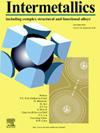Microstructures and mechanical properties of Zr-based metallic glass composites plasticized with titanium wire mesh
IF 4.3
2区 材料科学
Q2 CHEMISTRY, PHYSICAL
引用次数: 0
Abstract
Adding a second phase to metallic glasses to prepare metallic glass composites is an effective and commonly employed approach for plasticizing metallic glasses. In this study, a newly designed die-casting process was adopted to incorporate titanium wire mesh as the second phase into the Zr41.2Ti13.8Cu12.5Ni10Be22.5 (at%) metallic glass, successfully fabricating metallic glass composites with good plasticity. The detection results indicate that the interface between the second phase and the metallic glass matrix in the metallic glass composites fabricated by this process exhibited favorable metallurgical bonding, with no generation of brittle intermediate phases. Furthermore, the incorporation of the second phase can effectively induce the generation of multiple shear bands, and thereby enhance the plasticity of the metallic glass composite. The research results on mechanical properties indicate that when the wire diameter and pore size of the titanium wire mesh are 60 μm and 135 μm respectively, the compressive strength of the metallic glass composite is 1.59 ± 0.02 GPa and the compressive plastic strain reaches 11.8 ± 0.7 %. This research not only offers a novel method for the preparation of metallic glass composites but also provides a reference for the microstructure design of high-plasticity metallic glass composites.
钛丝网增塑zr基金属玻璃复合材料的组织与力学性能
在金属玻璃中加入第二相制备金属玻璃复合材料是一种有效且常用的金属玻璃塑化方法。本研究采用新设计的压铸工艺,将钛丝网作为第二相加入到Zr41.2Ti13.8Cu12.5Ni10Be22.5 (at%)金属玻璃中,成功制备出具有良好塑性的金属玻璃复合材料。检测结果表明,该工艺制备的金属玻璃复合材料中,第二相与金属玻璃基体之间的界面表现出良好的冶金结合,没有产生脆性中间相。此外,第二相的加入可以有效诱导多个剪切带的产生,从而提高金属玻璃复合材料的塑性。力学性能研究结果表明:当钛丝网的丝径为60 μm、孔径为135 μm时,金属玻璃复合材料的抗压强度为1.59±0.02 GPa,压缩塑性应变达到11.8±0.7%;本研究不仅为金属玻璃复合材料的制备提供了一种新的方法,而且为高塑性金属玻璃复合材料的微结构设计提供了参考。
本文章由计算机程序翻译,如有差异,请以英文原文为准。
求助全文
约1分钟内获得全文
求助全文
来源期刊

Intermetallics
工程技术-材料科学:综合
CiteScore
7.80
自引率
9.10%
发文量
291
审稿时长
37 days
期刊介绍:
This journal is a platform for publishing innovative research and overviews for advancing our understanding of the structure, property, and functionality of complex metallic alloys, including intermetallics, metallic glasses, and high entropy alloys.
The journal reports the science and engineering of metallic materials in the following aspects:
Theories and experiments which address the relationship between property and structure in all length scales.
Physical modeling and numerical simulations which provide a comprehensive understanding of experimental observations.
Stimulated methodologies to characterize the structure and chemistry of materials that correlate the properties.
Technological applications resulting from the understanding of property-structure relationship in materials.
Novel and cutting-edge results warranting rapid communication.
The journal also publishes special issues on selected topics and overviews by invitation only.
 求助内容:
求助内容: 应助结果提醒方式:
应助结果提醒方式:


